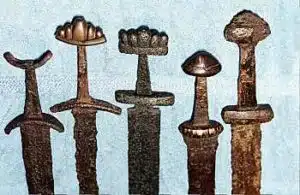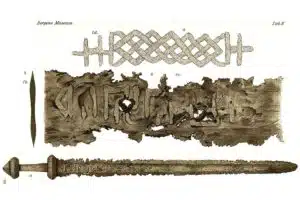Even if you don’t have heritage from Scandinavia, if I said “viking” to you and asked for your associations I wouldn’t be surprised to hear a few references to Thor or Odin or some other mythological figure. Also likely to be on the list would be “pillaging” and to be sure vikings pillaged. Also on the list would surely be a helmet with horns sticking out the side – these weren’t really common but, sure, let’s put that on the list too. But certainly you’d probably mention swords.
Now swords are absolutely part of the soul of viking warfare but they were incredibly expensive to make and according to the Fóstbræðra saga very few vikings were ever armed with swords. But the skilled smiths of the late Iron Age managed to make solid iron swords that would largely stand up in battle and get passed down from father to son. Swords with names like “Fótbítr” (Leg Biter) or “Brimir” (Brimming With Blood) are certainly dramatic and fit our image of the warring viking.
But we also know that while the later Iron Age smiths were quite skilled in the craft of forging the actual material wasn’t really ideal for fighting and most (but not all) swords would have been more for show or ceremony. Other weapons were far more reliable – clubs, axes, and small knives for example. To this point, in chapter 49 of Laxdæla saga, the viking warrior Kjartan was ambushed as he rode up a valley. He was not carrying his usual sword, a gift from the king, but rather a lesser sword. Several times during the battle, Kjartan had to straighten his bent blade by standing on it. That said, viking swords were better than their neighbors and that was all that really mattered by and large.
If you read the sagas and the eddas you’ll find that many of the swords mentioned sing, speak, prophesied, and give counsel. The swords were considered to be alive. This wasn’t a metaphor. To the viking mind the forge was considered to be feminine and the smith was considered married to the forge and it was his labor that drew the soul of the sword out of the inferno of the womb of the forge to birth a blade. Over a thousand year span the smiths started a mythochemical process of making their swords stronger and better.


Recent excavations and chemical analysis shows that later Iron Age viking forges had human and animal bone coal (like charcoal but with bones instead of wood) in their forges which in many cases could be matched to nearby burial mounds. The addition of carbon in the form of bone coal to their rough iron would have made a kind of proto-steel that would have made for stronger swords. But it is likely that the viking smiths didn’t know about free electrons in carbon or chemical assays but they did venerate their ancestors and call on them.
So, what do we know? We now know that vikings would take select bones from burial mounds and make bone coal with, say, the arm bone of a grandfather or the leg bone of a horse and leave the rest in the burial mound. This isn’t written down but we can imagine that over a thousand years viking smiths deepened their understanding of their craft and at some point likely asked the question something like this…
Answer me, Forge! thou knowest all, Old Woman, of the fate of swords:
What call they to make the strength of iron great, that keep the enemies tame, in each and every world?”
And The Old Woman Forge replied:
“Burnt bones of thy fearsome ancestors for vigor and the smolder of the ancient steed for quickness. Such might be your Prayer For The Rain of Victory.”
This is a poetic imagining that uses a small section of the Alvismmal, another viking saga, as a model form for questions and answers in the viking world but it makes sense. To speak to a forge as if it were alive would have absolutely been normal. And to receive an answer would also be completely comprehensible. But to be clear, early viking smiths didn’t have bone coal and their swords were not as good, later viking smiths had bone coal of dead ancestors and animals mixed into their iron and their swords were significantly stronger and held better edges.


Week after week here in this newsletter I make the case that these ancient ancestral traditions have mattered to making culture and may have echoes in these modern times often bereft of culture and a sense of place. Often calls to ancestral things seem a matter of mindset and a bit of a shoulder-shrugged “hey, give it a whirl…why not?”-ness. But here we have an example where remembering human and non-human ancestors and calling on their help did a real physical thing in the world. And so I’d make a plea that if you decide to wonder about such things that it might not always be and abstracted feel good thing to take up. These kinds of practices make for good soil, plentiful food, and stronger swords. But I’m sure other things too.
Thanks for being willing to wonder about such things with me week to week.
If this post brings up any questions or comments – send them, I’d love to speak to them if I can.

